MIG welding is one of the most common welding methods today, but you will need a proper shielding gas to do it right. Gas that comes out MIG gun plays a crucial role, as it shields the weld pool from defects.
Since MIG welding is popular among beginners and hobbyists, they often wonder what’s the best gas for MIG welding?
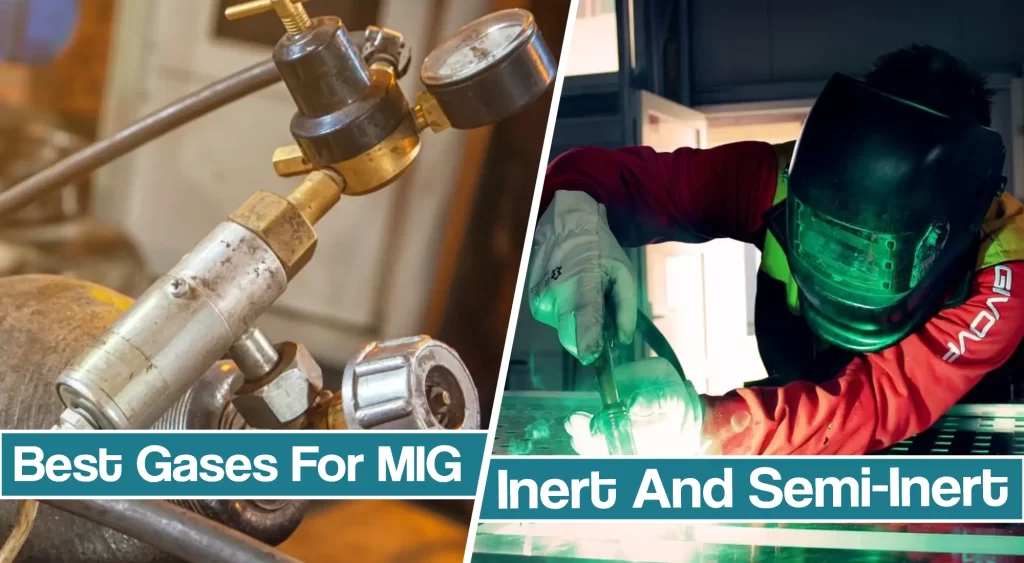
There is no simple answer, as the results may vary of given material type and conditions. However, today, welders often consider 75% argon and 25% CO2 mix as a go-to blend for mild steel.
So, let’s look at MIG welding shielding gases and their properties.
Best Common Shielding Gases for MIG Welding in a Nutshell
To keep it simple, MIG welding is impossible without the shielding gas. Furthermore, as the molten weld pool solidifies, it reacts with the gases in the atmosphere, causing corrosion and various defects such as porosity.
Therefore, once you add certain gas or a mixture of MIG welding gases, your solid wire electrode produces clean welds. (Flux Core wires that you can use without MIG welding gases for welding also produce a cloud of the shielding gas around the electric arc and the molten pool.)
The first research of welding into the protective environment was done in the 1920s by scientists Alexander and Langmuir. However, H.M. Hobart and P.K. Devers used argon and helium welding atmospheres, resulting in a 1926 patent.
In MIG welding, you will most commonly use inert, semi-inert, and reactive gases. Each type has its characteristics, and in this section, we will explain them thoroughly.
Inert Gases – Argon and Helium
An inert gas, like all noble gases, resists any chemical reactions. Therefore, using inert gasses to shield the pool will result in less spatter and cleaner weld.
Even though there are five noble gasses, MIG welders utilize Argon and Helium. Both are used in TIG welding but are usually pure (100%), while in MIG welding, they typically mix 25/75% to achieve better results.
Argon Shielding Gas for MIG Welding
Argon is a noble gas that resists any chemical reactions, meaning it will protect your weld pool from defects perfectly. Besides carbon dioxide, argon is one of the most common shielding gases frequently used in MIG welding.
As a shielding gas, Argon provides a stable arc, but a broader finished weld and somewhat more shallow weld penetration, eventually fine for butt and fillet welds.
Therefore, argon is usually mixed with other gases to increase its properties and protection.
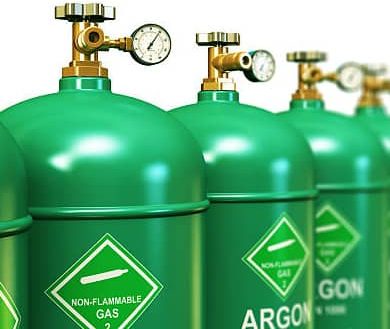
There is another reason for mixing, and that’s the price. Inert gases are expensive, so adding 5-25% of carbon dioxide will significantly reduce costs. However, when welding aluminum, titanium, and magnesium, you will have to use 100% (pure) argon to ensure the best results.
Helium in MIG Welding
Helium, just as Argon, is an inert gas that provides exceptional shielding characteristics. However, compared to Argon, Helium burns hotter for a deeper weld. That’s why these two combine properties and produce consistent weld when mixed.
On the other hand, Helium requires a higher gas flow rate. Unfortunately, high gas flow rate combined with a high price makes Helium an unpopular choice for hobbyists and occasional welders.
Even though it provides favorable properties, Helium is mainly used in two-gas or even three-gas combinations when working with stainless steel.
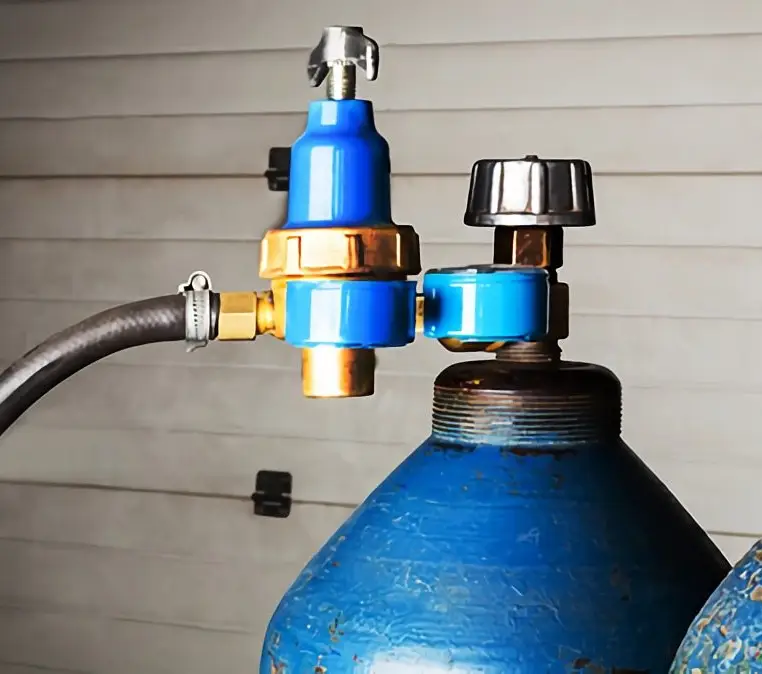
Semi-inert Gases in MIG and TIG welding
Semi-inert gases resist chemical reactions but somewhat less than noble gases. Therefore, they can provide decent weld pool protection, but with a certain amount of spatter and posts weld cleaning.
CO2 is significantly cheaper than noble gases, making it quite popular among MIG welders. However, it is not suitable for TIG welding due to reactivity with tungsten.
CO2 (Carbon Dioxide) in MIG Welding
Due to its price, carbon dioxide is one of the widely used MIG welding shielding gases. Carbon dioxide provides deep weld penetration, which is perfect when working with thicker metals. However, welding with carbon dioxide as semi-inert gas may result in more weld spatter and less steady arc.
Nonetheless, you can even use 100% CO2 when MIG welding certain material types. Pure carbon dioxide provides very deep weld penetration, making it great for welding thick material. However, when welding thinner metal gauges, you should expect a burn-through.
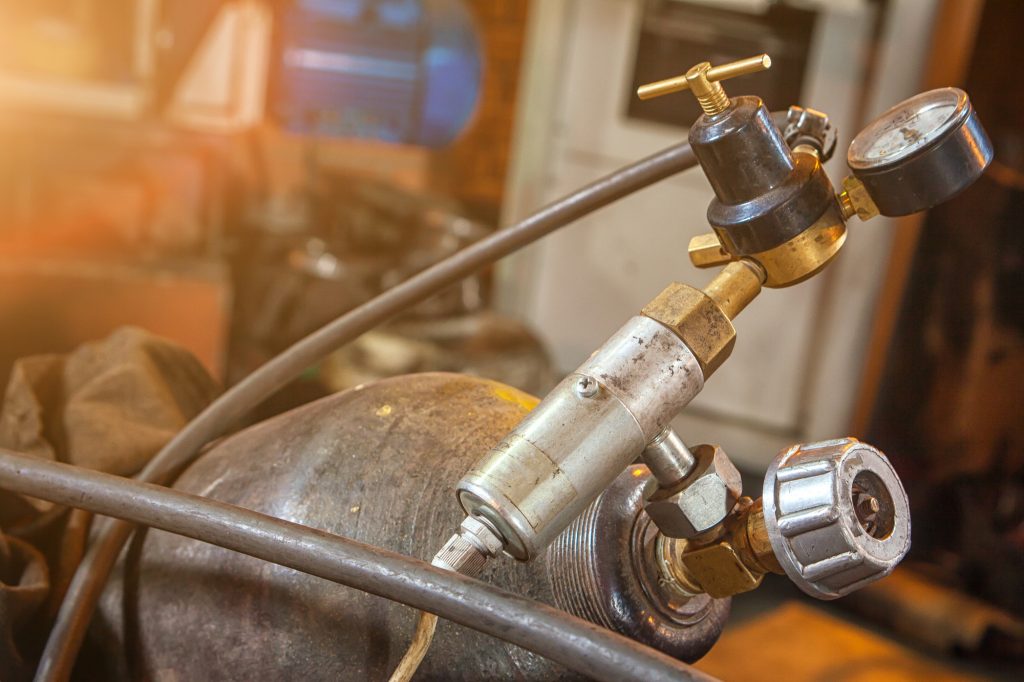
On the other hand, CO2 is considered a general-purpose MIG welding shielding gas, most often used with mild carbon steel.
As we mentioned above, CO2 is often added to the Argon mix to increase penetration and reduce costs. Thus, a couple of popular combinations are C25 (75% Ar, 25% CO2) or a trimix 72/25/3 Ar/CO2/He.
Shielding the welding arc with Reactive Gases
As their name states, reactive gases are prone to a chemical reaction, which means you cannot use them. However, they show some positive characteristics that affect the weld quality.
Reactive gases, such as Oxygen, increase the fluidity of the weld, but they are prone to oxidation in the weld bead. That’s why they are always used in a two or a tri-gas mix, and with no more than 10%.
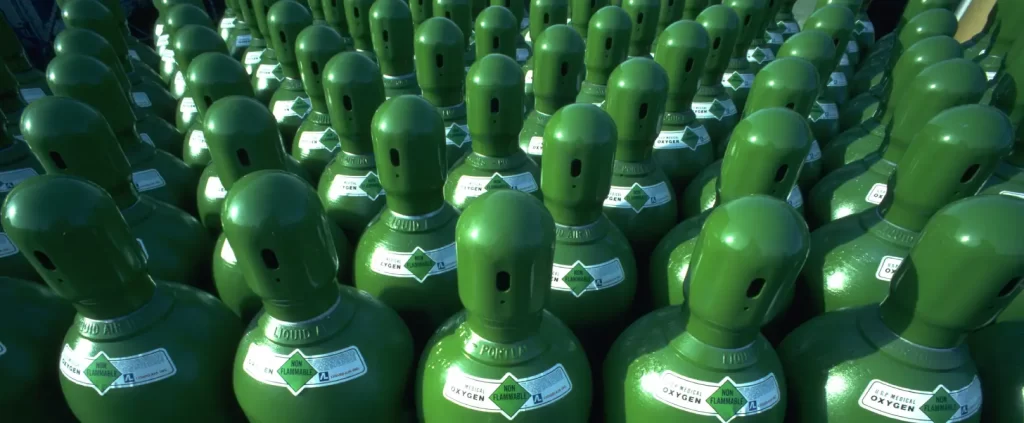
Oxygen in MIG Welding
Oxygen is a reactive gas that interacts with the weld pool, eventually leading to weld oxidation. However, in small amounts of 1-9%, oxygen will improve weld pool fluidity, arc stability, and penetration.
This shielding gas is often used in a mix when welding carbon steel, stainless steel, and low alloy steel. However, you cannot use oxygen with titanium, magnesium, copper, or other non-ferrous gases due to its reactivity.
Hydrogen and Nitrogen in MIG Welding
Hydrogen as a shielding gas is often part of high-temperature applications. As with other reactive gases, it is commonly used in small percentages (1-2%) as part of the mix in welding austenitic stainless steel.
Nitrogen is commonly used as a purging gas, but a small percentage of 1-2% can serve as a shielding gas. Therefore, nitrogen is used in a tri-mix with argon and 20-30% helium when welding stainless steels, nickel-copper, and nickel-based alloys.
Best Gas Mixtures for MIG Welding
As you might have noticed from everything we said so far, each gas has advantages and drawbacks. For example, even argon, considered one of the most common and cleanest shielding gases, doesn’t perform well in all applications.
That’s why welders started mixing various shielding gases to get the best out of each, whether economics, penetration, heat, or bead appearance. Hence, two-gas or tri-gas mixtures are getting more popular.
Best Two-Gas Mixtures for MIG Welding
75% argon, 25% CO2
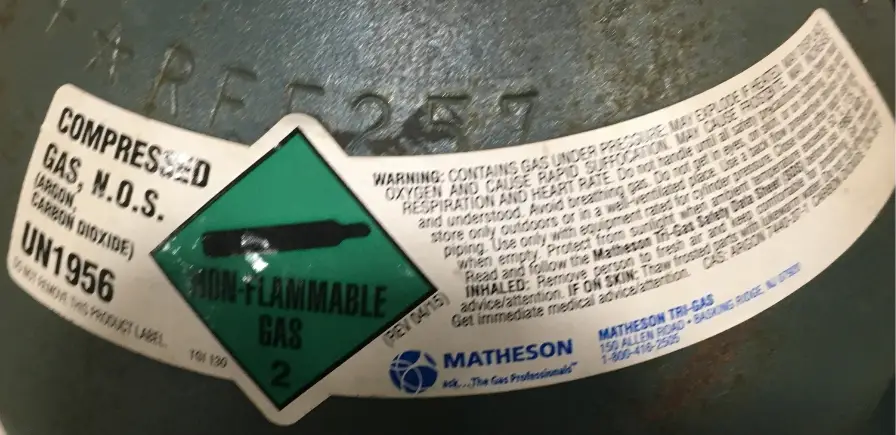
This is one of the best and most commonly used two-part blends in MIG welding, and there is a reason. As an inert gas, argon provides excellent weld protection combined with fantastic arc stability. However, argon somewhat lacks penetration, and yeah, it is expensive.
That’s where CO2 kicks in. CO2 provides better penetration, it is cheap, but it tends to produce spatter and fumes as semi-reactive gas. When argon and CO2 are mixed, they provide excellent shielding of the bead with enough penetration. As a result, you can work faster, the mixture is economical, and the spatter is reduced.
That’s why 75/25 Ar/CO2 mix, also called C25 mixture, is one size fits all choice when working with mild steel. However, it is not suitable for aluminum, stainless steel, or other non-ferrous metals.
75% argon, 25% helium
This is a perfect mixture when the weld’s cleanness is mandatory, making it ideal for welding aluminum or non-ferrous metals.
Both gases provide exceptional weld shielding, but helium increases penetration and weld fluidity. However, remember that both gases are costly, so you should use them only when necessary.
98-99% argon, 1-2 oxygen, or CO2
This mixture is often used when welding austenitic, duplex, ferritic, or high alloy austenitic stainless steel. A high percentage of argon shields the weld, where small additions of oxygen or CO2 stabilize the arc, improve the fluidity and improve the quality of the weld deposit.
CO2 provides better short-arc welding and positional welding properties, while oxygen offers Higher fluidity of the molten pool.
Best Tri-Gas Mixtures for MIG Welding Mild steel, Stainless Steels, and Nonferrous Metals
- Argon/CO2/Oxygen – adding small amounts of oxygen to the already most popular shielding gas mix of C25 increases the weld fluidity. Thus, excellent spray arc welding transfer enhances efficiency and arc stability leading to more visually appealing welds.
- Argon/Helium/CO2 – this mix is used with pulsed-spray transfer process in MIG welding stainless. Small amounts of CO2 (1-2%) can increase the travel speed, and Ar/He/Co2 mixture works fine weld metal-carbon control is essential.
- Argon/CO2/H2 – shows the best results when MIG welding 300 series stainless steel. The presence of hydrogen produces optimum bead color and shape. In addition, Ar/CO2/H2 mixture minimizes oxide formation and enhances fluidity. However, it shouldn’t be used when welding plain carbon steel.
- Helium/Argon/CO2 – is an industry-standard mixture when MIG welding stainless steel using a short-circuit transfer method. Remember that this mixture produces a good bead shape and color match, but it’s not as versatile as other blends.
- Argon/CO2/N2 is another blend that utilizes only short-circuit transfer, reducing overall productivity. However, remember that nitrogen in the mix is not recommended when joining stainless to carbon steel.
How To Properly Choose The Shielding Gas
Even though we thoroughly explained the characteristics of each shielding gas, there are a couple of things you should consider before making a choice.
Welded material type
As you might have noticed, shield gases perform differently according to material type.
Inert gases such as argon and helium can be used in various applications (steel, stainless, aluminum, non-ferrous metals, other exotic metals).
In contrast, reactive gases such as oxygen or nitrogen fall off when cleanness is vital (aluminum, magnesium).
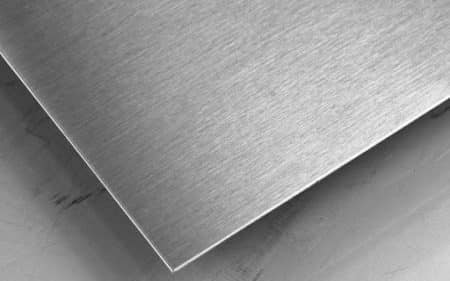
Shielding Gas Cost
Even though inert gases show better weld performance and work great in fillet and butt welds, they are also expensive. That’s why many choose CO2 mix or even pure CO2 when working with mild steel welding.
Also, different tank sizes differ substantially in price, so based on the amount of work and consistency of it you might be needing a smaller welding gas cylinder. As a hobbyist or a small shop owner, you will need approximately 60-80 or up to 125 cf cylinders of gas.
An 80 cf cylinder filled with 100% argon costs approximately $295, while you will have to pay more than $340 for the same amount of helium. For example, the same size shielding gas cylinder filled with CO2 costs approximately $200, but the price of the later refill is only about $25. Oxygen tank refills cost near $30 for smaller tanks but refilling the cylinders larger than 300 cf is estimated at $35.
Characteristics Of A Welding Gas
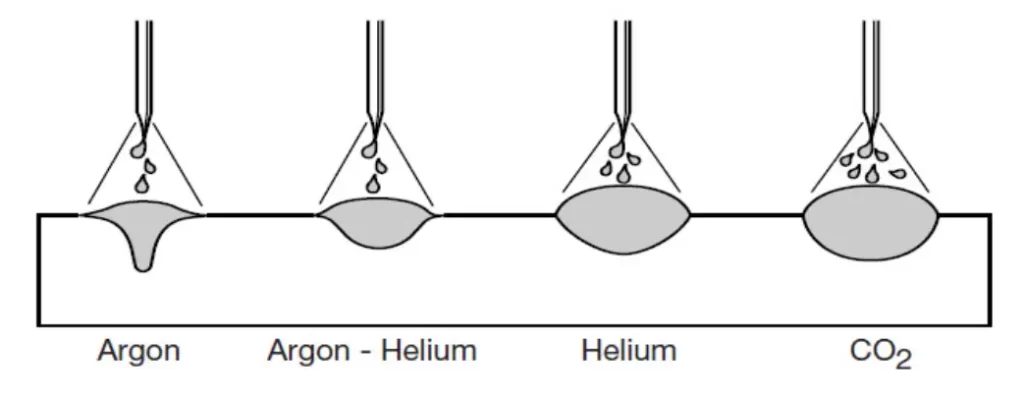
Each shielding gas shows different finished weld properties. For example, carbon dioxide increases the penetration but causes fumes and requires post-weld cleaning.
On the other hand, shielding gases composed purely, such as argon ensure clean welds without spatter but have a somewhat shallow penetration. That’s why many welders mix the gases to achieve the best weld deposit properties.
Productivity
For the best productivity, you should choose gases that allow spray transfer, such as 75% Ar 25% CO2. In addition, reactive gases such as oxygen increase the pool fluidity, which helps you work faster. Compared to Stick welding, MIG is significantly faster as it offers different weld transfer processes.
If this read is not enough or you might be looking for a different welding process that uses some different welding gases you can check this article here.
What Is The Best Gas to use for MIG Welding?
There is no correct and straightforward answer to what is the best gas for all MIG welding applications. As you could deduce, different gases show different characteristics, but welders worldwide seem to favor the 75% Argon 25% CO2 mix.
This blend mixes the good sides of both gases, including arc stability, penetration, performance, and price. Even though this is a go-to mixture when welding mild steel, you will have to take a different approach if welding stainless, aluminum, or other non-ferrous metals.
So before you choose, consider the aspects such as material type, cost, characteristics, and productivity.
We comprehensively explained the good and the bad so you can make your next weld as perfect as possible.
Resources:
- The fundamentals of MIG welding gases by American Torch Tip https://americantorchtip.com/blog/the-fundamentals-of-mig-welding-gases/
- A Shielding gas guide for GMAW by The Fabricator https://www.thefabricator.com/thewelder/article/arcwelding/a-shielding-gas-guide-for-gmaw
- MIG Welding gas review by MIG Welding UK https://www.mig-welding.co.uk/welding-gas.htm
- MIG Welding: The Basics for Mild Steel by Miller Electrics https://www.millerwelds.com/resources/article-library/mig-welding-the-basics-for-mild-steel
- Best gas mix when Mig welding mild steel by Welding Tips and Tricks https://www.weldingtipsandtricks.com/best-gas-mix-when-mig-welding-mild-steel.html





